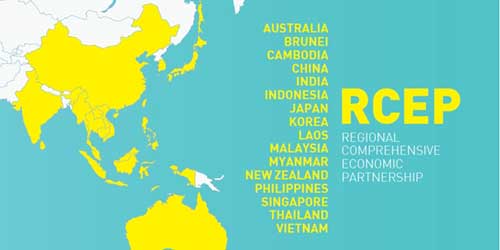With China and Singapore working to expedite talks on the Regional Comprehensive Economic Partnership (RCEP), it is worth taking a closer look at the oft-talked about trade proposal.

Negotiations over the partnership began on 20 November 2012, between the ASEAN members and China, India, Japan, South Korea, New Zealand, and Australia. The ASEAN states already have free trade agreements with the other six states individually, but the RCEP aims to create a larger free trade bloc which will account for nearly 3.4 billion people and make up approximately 30% of global GDP.
Given its expansive reach, the RCEP agreement could have significant benefits for Australian businesses and consumers. Many RCEP member states are already major trading partners with Australia. Having a singular trade agreement that encompasses 16 countries will work to simplify the trading process and increase market access. Australian businesses would have the opportunity to take advantage of an expansive and diverse market, and benefit from the removal of trade barriers such as tariffs and quotas. This would be especially beneficial for Australian businesses hoping to enter the Indian market, as Australian-Indian trade relations have previously been restricted by a three tiered tariff system.
Moreover, Australian consumers would also benefit from an increased variety of cheaper products coming in from RCEP member states. By including countries export-oriented economies with high purchasing power parity such as China and Indonesia in the agreement, the flow of goods between countries would be mutually beneficial.
The RCEP member states are largely Asian and Australasian. It can be argued that membership of such a comprehensive and regional agreement is long overdue for Australia, as most of its trade relations are bilateral. While the US currently holds a protectionist view on trade agreements, European countries benefit from the free trade flow governed by the European Union and a number of regional free trade agreements govern African and Asian trade.
A regional trade agreement will not only benefit the Australian economy, but will also further Australian diplomatic ties with RCEP member states. China, India, and Indonesia are all positioned to be rising economies and hold considerable regional influence. It is in Australia’s strategic interests to form stronger ties with countries in Asia and the Pacific given their regional proximity.
Since its launch in 2012, there have been 18 Rounds of negotiations, with considerable ground being covered each time. The most recent Ministerial Meeting held in May 2017, rules to protect intellectual property rights and a dispute settlement mechanism were established. It was also stressed that member states needed to continue to collaborate efficiently to meet the intended deadline in December 2017.
The urgency to hasten RCEP negotiations could be explained by the Untied States’s decision to pull out of the Trans-Pacific Partnership (TPP). The TPP was viewed as a rival trade agreement led by the US under President Obama, which excluded both India and China. The Partnership aimed to “lead the way” on global trade instead of China, and counter Chinese attempts to formalise RCEP.
Normally, it is the duty of the World Trade Organisation (WTO) to regulate international trade and set minimum standards. However, the WTO’s Doha Round has seen minimal progression since its inaugural Ministerial Conference in 2001.
With the WTO’s Doha negotiations in deadlock, the viability of separate multilateral trade agreements becomes more attractive for countries looking to expand their trade capacities. This, along with the uncertainty over the future of the TPP, demonstrates that the proposed RCEP agreement holds great significance for Australian trade.
